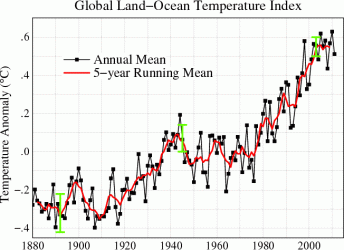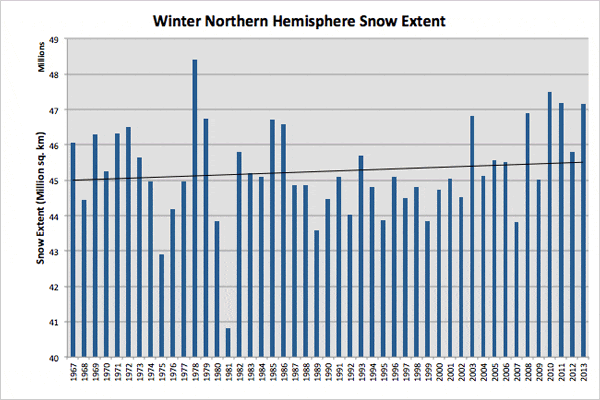ScienceRocks
Democrat all the way!
- Banned
- #1
Yep, it's now appearing that we're no longer following the .13-.15c per decade trend that would take us from .545, 2010 to .67-.695 by 2020 for the global means temperature. I'm not sure what root to believe 1# energy being stored deep in oceans Andrew Dauser or 2# Spencer theory of an increase in cloud cover reflecting it back into space. I'm going to play it safe in believe that the energy that's we know of is the main player and forecast the trend closer to .62-.64 by 2020. Avg means of .63c...
Some of the factors why I believe this
1# Most of the warming has occurred within the Arctic with very little throughout the remainder of the world. Most of it is being caused by arctic amplification of the exposed area of arctic ocean without ice. I believe look at increase in snowfall during the winter into spring should cause that time period to remain around 13-15 million sq miles of sea ice. While the summer and fall should grow with a steeper difference. Pretty much I expect by 2015 that sea ice during the minimum to reach ~3.2 million miles for avg summer sea ice and 2.7 million miles for avg sea ice by 2020. This will lead 80% of the global temperature increase. So the increase in snow fall during the winter-spring will be a negative on the warming.
2# By 2015-2018 period we will start tracking into the next solar minimum. This one after this weak one could put a negative effect on the climate system.
3# Overall cool ENSO period like 1970's. This will have some effect over the next 3-8 years. .03c mean negative factor.
I see no increase in the rate of warming...In fact I see a flatting of the slope(decreasing rate of increase). I think a case could be made that the warming could be down to around .07-.09c per year from .013-.015c, 5 years ago and .018c/year in the late 1990's. Of course we won't know for sure until the middle part of this decade based on the rules of stats.
Some of the factors why I believe this
1# Most of the warming has occurred within the Arctic with very little throughout the remainder of the world. Most of it is being caused by arctic amplification of the exposed area of arctic ocean without ice. I believe look at increase in snowfall during the winter into spring should cause that time period to remain around 13-15 million sq miles of sea ice. While the summer and fall should grow with a steeper difference. Pretty much I expect by 2015 that sea ice during the minimum to reach ~3.2 million miles for avg summer sea ice and 2.7 million miles for avg sea ice by 2020. This will lead 80% of the global temperature increase. So the increase in snow fall during the winter-spring will be a negative on the warming.
2# By 2015-2018 period we will start tracking into the next solar minimum. This one after this weak one could put a negative effect on the climate system.
3# Overall cool ENSO period like 1970's. This will have some effect over the next 3-8 years. .03c mean negative factor.
I see no increase in the rate of warming...In fact I see a flatting of the slope(decreasing rate of increase). I think a case could be made that the warming could be down to around .07-.09c per year from .013-.015c, 5 years ago and .018c/year in the late 1990's. Of course we won't know for sure until the middle part of this decade based on the rules of stats.







 The meterologists can't even predict the temperatures next week, never mind next year or 20 years from now.
The meterologists can't even predict the temperatures next week, never mind next year or 20 years from now.